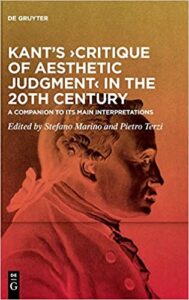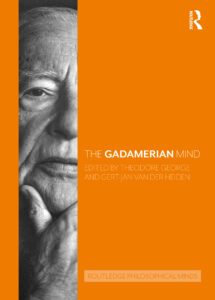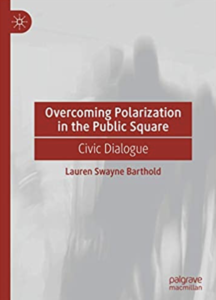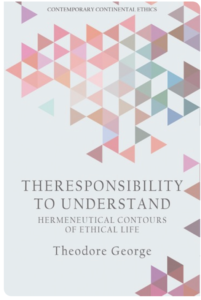Below are my comments from a recent book panel on Lorenzo Simpson’s excellent book, Hermeneutics as Critique: Science, Politics, Race, and Culture, at the North American Society for Philosophical Hermeneutics. At the conference, I presented only half of the comments, so I thought it might be helpful to present them in full here. Enjoy! Cynthia R. Nielsen
Introductory Comments
Lorenzo Simpson’s book, Hermeneutics as Critique: Science, Politics, Race, and Culture, brings philosophical hermeneutics to bear on important contemporary issues such as race that have not been particularly prominent in the hermeneutical tradition.
As he states in the Introduction, “I steer philosophical hermeneutics along paths that it does not typically tread. I aim to develop a philosophical hermeneutics with critical intent and seek thereby to demonstrate the ongoing relevance of hermeneutic approaches to matters far beyond the field of literary and textual analysis” (1). Likewise in the Introduction he outlines some of the key criticisms leveled against philosophical hermeneutics, focusing on two in particular. The first is the claim that hermeneutics is “unable to critically interrogate the status quo of a given tradition” due to its concern with understanding others within their own context and terms. The second is the charge that hermeneutics amounts to relativism given its emphasis on the contextuality of knowledge” (7). In fact, one of the broader goals of the book is to help to create ways of dialoguing that “would bridge the gap between a merely culturally bound interpretation and a respectful transcultural criticism” (x).
In his previous work, Simpson attempts to strike a balance between the need to “acknowledge social and cultural difference” and “to counter claims that differently situated persons and cultures are . . . ineliminably opaque to each other” (8). Thus, his focus has been to develop a position that responds to incommensurability by “defending a framework in which differences of cultural viewpoints can be interpreted and understood as different perspectives on the same range of issues” (8). In his present book, he develops what he calls “critical hermeneutics” or “hermeneutics as critique,” which supplements and advances a largely Gadamerian framework (8). In fact, in the Introduction, Simpson articulates three aspects of Gadamerian hermeneutics that animate his argument: “[1] the idea of a dialogically enabled and endorsed fusion of horizons; [2] the nature of concept formation; and [3] the hermeneutic centrality of the ‘dialectic of question and answer’” (4) Regarding the need to supplement Gadamer’s account, Simpson points to the Habermas-Gadamer debates of the 1960s and 70s, in which Habermas claimed that Gadamer’s hermeneutics was incapable of granting a “systematic distinction between an ideological regime and a nonideological one” (9) Even though in the course of their continued dialogue, Habermas moved closer to Gadamer on several points, Habermas remained critical of Gadamer’s “more situated and contextualized account” of knowledge. In defense of his position, Gadamer argued that his view of prejudices as the conditions for knowing did not entail that certain prejudices were “beyond criticism.” In fact, as Simpson observes, Gadamer allows for both legitimate and illegitimate prejudices and intimates that such a distinction “could serve as an effective stand in for ideology critique. Simpson grants this distinction but seeks to develop a more robust account of how it might be deployed for critical purposes such as the critique of ideology.
Simpson’s book also aims to address criticisms levelled at Gadamer’s statements about hermeneutics’ universality. For example, he describes his present work as “a contribution toward the redemption of Gadamer’s claim that hermeneutics is ‘a universal aspect of philosophy’ (10). Part of Simpson’s strategy is to show how a Gadamerian critical hermeneutics can be deployed not only in the realm of social critique but also in the realm of scientific investigations. (Chapter 1, which I will not be discussing, is devoted to demonstrating how critical hermeneutics can be fruitfully brought to bear on scientific theory choice.)
Chapter 2: “Critical Fusion: Toward a Genuine Hermeneutics of Suspicion”
Now that I have offered a broad sketch of the book and highlighted some of its objectives, my remaining comments are directed at Chapter 2, which is entitled “Critical Fusion: Toward a Genuine Hermeneutics of Suspicion.” In chapter 2, Simpson’s aim is “to demonstrate the critical potential inherent in hermeneutical approaches to social and cultural understanding” (13). He begins by discussing three conditions, in which “internal or ‘immanent’ normative pressure” can be deployed hermeneutically in the investigation of social and cultural practices (13). The first condition is the fact that cultures are heterogenous rather than “homogenous wholes.” Likewise, cultural identity is neither uniform nor static but dynamic and always in process of negotiation. Cultural identity is thus better “understood as a ‘cluster’ concept, whereby certain elements of the set of features that collectively constitute one’s social identity may be revised as a result of critical reflection without resulting in the loss of identity” (13–14). The second condition is his notion of “second-order rationality,” which is a “mode of rationality that has a culturally invariant purchase” (59). The third condition is what he refers to as “counterfactual dialogical critique” (59). I will discuss conditions two and three in more detail in the course of my commentary; however, first I turn to Simpson’s case for a hermeneutics of intercultural understanding.
Hermeneutics of Intercultural Understanding
Simpson contends that genuine—by which he means non-invidious—understanding of other cultures is possible. Essential to a critical hermeneutics and proper hermeneutic understanding is the interpreter’s ability to make intelligible the other culture in such a way that that culture would recognize itself in the interpreter’s account. That is, understanding another culture’s aims, assumptions, institutions, pursuits, and so forth are intimately connected to and make possible “meaningful critique” of the culture under investigation (61). Simpson goes on to say that “If we pay adequate attention to these facets of interpersonal or intercultural hermeneutic understanding, we will discover that the potential for meaningful critique is an ineliminable internal feature of such understanding” (61). Here Simpson begins to foreground what will become significantly more clear in the latter part of the chapter when he discusses how conditions two and three are operative in an intercultural exchange. Simpson’s description thus far highlights how he is working squarely within a Gadamerian framework. For example, what Simpson describes in this section is a hermeneutics of charity, which I take to be fully in line with Gadamer’s way of engaging texts, artworks, and so forth. Yet, Simpson’s development of Gadamer’s insights to show their critical import also serves as a counter to Habermas’ claim that Gadamerian hermeneutics is critically impotent.
As Simpson’s develops his account of intercultural dialogue, his use of Gadamer’s notion of a fusion of horizons becomes evident. For example, Simpson writes that a genuine intercultural dialogue “will emerge from a distinctive kind of dialogue whose vocabulary does not fully precede the dialogue itself. It is rather a dialogue that is enabled by ongoing practices of forging commensurable or mutually enriched vocabularies for identifying and discussing differences, vocabularies that enable a mutually respectful exchange about matters of common concern among people differently situated” (61). What Simpson articulates strikes me as in complete harmony with Gadamer’s account of the fusion of horizons and the need to dialogically engage in a spirit of openness with, for example, a text or artwork, allowing it to speak and responding to what it has to say. The process of refining our projected meanings and assumptions is, for Gadamer (at least as I understand him), part of the process of forging a common language that can then give rise to mutual understanding about the subject matter at hand, which is, of course, different from mutual agreement. In other words, a common language is never given or assumed as already in place. (Simpson seems to suggest at times in this section that Gadamer assumes a common language.) Rather, for Gadamer tradition—or better traditions—are, like cultures, always multiple, changing, and in process of being negotiated by the diverse parties that identify with particular traditions as well as those who find themselves in conflict with a particular tradition.
Other statements that Simpson makes about Gadamer’s notion of tradition and authority and how the two relate raise questions for me. For instance, Simpson states that Gadamer’s “tendency was to focus on the tradition that both text and interpreter share.” He goes on to add: “Gadamer is preoccupied [… with] the vertical relationship of an authoritative tradition to an interpreter,” whereas his own—that is, Simpson’s—approach focuses on “a horizontal relationship between interlocutors” (62). I take Gadamer’s view of authority to be, like traditions, also always under negotiation and contestation. That is, authority, contra certain Enlightenment characterizations, is not understood as that which one blindly accepts and in so doing signals intellectual laziness, as Kant might put it. In Gadamer’s critical remarks, he draws attention to and argues against the assumed false dichotomy between authority and reason that underlies certain Enlightenment philosophers (e.g., Descartes). In contrast, Gadamer’s view is that while authority can be and is abused, there can also be and are relationships and communities in which authority has a positive and non-dominating role. In such instances, authority is acknowledged because the person, community, institution, and so forth has demonstrated in practice that they are, in fact, knowledgeable, trustworthy, and in possession of some wisdom or know-how that one recognizes and from which one desires to learn. Consider someone who wants to learn jazz guitar and has the opportunity to study with Pat Metheny or John Scofield at Berklee College of Music. Both guitarists are recognized as master jazz guitarists and thus have a certain authority (based on their knowledge, skill, and grasp of the instrument and the tradition of jazz guitar-playing), and the school as an institution is known for its excellence in teaching and musical innovation etc. Given that recognition, there is a deference to those perceived as having more knowledge, understanding, experience, or know-how of a particular topic or skill, but that in no way means that the authority of the person, group, or institution can never be challenged, shown to be problematic, or outright rejected. Nor does it necessarily translate into an instance of intellectual laziness or irrationality but rather can be understand as acting in harmony with reason.
Before moving to the final section of chapter two, I want to briefly comment on Simpson’s intriguing discussion of the epistemological unavoidability of “some degree of ethnocentricism” (64). Simpson begins by making a distinction between an unavoidable“transcendental” ethnocentrism in our interpretive endeavors and a harmful ethnocentrism. Describing the former, he writes: “To see others as engaged in, say, argumentative practices or in morally relevant practices requires our experience with those kinds of practice as a touchstone. And we can be sure, to pick morality, that if another culture’s criteria for the application of moral terms demonstrated no overlap with ours, we would have no reason to think that they were engaged in moral discourse at all” (64). He goes on to say that this type of unavoidable enthnocentrism should not overly concern us and gives two reasons as to why this is the case. First, he states that we can discern the difference between “the ‘transcendentally’ necessary ethnocentricism” in which we cannot help but to draw upon and utilize our own ideas of rationality, cogency, and intelligibility and the harmful kind of ethnocentricsm (64). The latter, he notes, can be resisted and its problematic assumptions exposed through intercultural dialogue “aimed at mutually acceptable descriptions of the Sache and of its correlative contrasting practices” (64). In other words, successful hermeneutic engagement in which both parties come to a mutual understanding of the subject matter involves not only projecting possible meanings but also confirmation of those projections through dialogue with the other. If one’s projected meanings are shown to be incorrect, then one must be willing to revise one’s assumptions, projections, and interpretive theories. Here again, what he describes is thoroughly Gadamerian.
Moving to his second reason as to why we should not be overly concerned with the unavoidable type of enthocentrism, he writes:
Who ‘we’ are is always under revision. Our identities are best viewed as being open to nonfatal contestation because certain elements of the set of features that collectively constitute one’s social identity may be revised as a result of critical reflection without resulting in the loss of that identity. Such a threat to cultural identity need not be feared if we acknowledge that identity is a cluster phenomenon in the sense that few if any beliefs or professions of value, taken singly, are essential to an identity (65).
While I agree and resonate with Simpson’s claim that descriptions of the self are “open to contestable interpretations,” I wonder whether there is not more risk of losing one’s social or cultural identity in certain instances of critical dialogical engagements than is intimated. In other words, being hermeneutically open to the other involves real risk. For example, one could argue that some social and cultural identities seem to involve certain “professions of value and clusters of beliefs” that are so central to those identities that to give those up or to no longer be able to agree and “feel at home” with them would result in the loss of one’s social or cultural identity and would thereby cause a crisis through which one would have to navigate. Examples of such identities are traditional religious identities that require belief in certain core dogmas or perhaps similarly belonging to a political party or group that requires belief in certain values and support of specific practices, policies, and so forth. However, even if the risk is stronger that Simpson acknowledges, I don’t think this causes any major problems for his overall account, but rather underscores the open possibilities of our hermeneutic being and the reality that we are ever-and-always underway—that is, everything that constitutes our social identity, including our values, beliefs, practices, and ways of being are not rigidly fixed; rather, as socially and historically formed, our identities are dynamically lived and capable of being altered. When a radical change takes place, one’s social identity can be experienced as fundamentally upended such that an existential crisis of identity occurs, which then sets in motion the process of forming a new social identity. In short, with its emphasis on openness, finitude, and our historical conditioning, hermeneutics as a way of life involves genuine risk.
Toward a Critical Hermeneutics of Intercultural Understanding
In the last section of the chapter, Simpson elaborates how his approach offers critical responses to “differently cultured others” (65). He begins by stating the following maxim as a methodological assumption of cross-cultural understanding: others have distinctive interpretations of the world that one can not only come to understand and respect but also from which one can learn. However, he quickly adds that this assumption is not an “indefeasible claim with respect to any particular case” and that there are “practices that defeat such a presumption” (66). Examples of such practices are human rights’ violations, which he discusses in his book, The Unfinished Project. Such abuses violate what he refers to as a “criterial property of the good life.” Spelling this out further, he adds: “I take the recognition of the centrality of the freedom of individuals to assent to or reject propositions put forward by others—propositions purporting to articulate what those individuals would endorse as being of central importance to them—to define a minimalist core of any set of criterial properties of the good life that would meet with reciprocal acknowledgment and survive the test of the conversation of humanity” (66). Hence, there is a kind of minimalist “ethic of human rights” that is required “for participation in such a conversation or as a claim about the minimalist core of any product of such a conversation” (65, 66).
Next, Simpson shows how his critical hermeneutics does not land us in crass relativism. It is in this part of the chapter that his notion of “second-order rationality” comes into sharper focus. Simpson begins by developing a counterargument to a view put forth by Richard Rorty. Rorty claims “that the only way to take seriously the distinction between the merely socially or culturally sanctioned, on the one hand, and the valid, on the other, is to adopt a discredited Platonic foundationalism.” Since no such foundation is forthcoming, there is “no non-question begging way . . . to critically evaluate or to referee conflicts between sociocultural practices” (67).
Contra Rorty, Simpson contends that one can appeal to internal grounds within cultural horizons for the purpose of critically evaluating social practices. Thus, it is not necessary to “appeal to anything beyond the standards of rationality or the central vocabulary of a particular cultural group” (67). Simpson adds that just as we can at least sometimes be shown and come to acknowledge that our own social practices and justifications for those practices are problematic and flawed, so too “there is no reason to think that others cannot be brought to see this as well” (67). Here we should recall Simpson’s earlier condition—namely, that cultures and social identities are never monolithic and have their own critical voices within—voices that offer critical arguments for why certain practices should be changed or done away with. In light of that reality, we can expect that, should we practice a hermeneutics of charity and take the time to understand a culture or group in a way that they would recognize themselves, a critical, cross-cultural engagement that could potentially bring about change is a genuine possibility.
In addition, every culture, whether explicitly or implicitly, claims that its practices and way of life offers the best path for its respective flourishing. At this point, Simpson appeals to his notion of second-order rationality. For example, he states that “This sort of culturally rooted validity claim provides the occasion or basis for a non-question-begging cultural critique informed by the presumption of what I call second-0rder rationality” (68). Moreover, second-order rationality, Simpson contends, is culturally invariant. As he explains: “It is the disposition or mode of rationality that we are entitled to impute to everyone—that is, an inclination to reform one’s practices in the direction of more rationality when one’s lack of rationality is pointed out in terms with which one is conversant” (68). A key takeaway is that by utilizing this mode of rationality one can distinguish between “what everyone in a particular epistemic community happens to believe and what is, by their own lights, reasonable for them to believe” and all without having to appeal to external standards of rationality or networks of intelligibility (69). In a cross-cultural exchange of this sort, a community or group within a culture could be made aware of their own problematic practices and justifications for those practices and begin the process of negotiating changes.
Here we return to counterfactual dialogical critique, which Simpson describes as “a conversational modality that can be triggered by an encounter with a social or cultural practice […] that may seem questionable even when pursued in cultural contexts in which members of the affected group themselves seem to be part of the consensus in its favor” (15). Underlying his notion of counterfactual dialogical critique is the assumption that those in other cultures can, through dialogical engagement, come to see other interpretive possibilities and practices that would not only be fitting with their own cultural identity and traditions but would also be beneficial and even preferable to them once realized. The realization of such possibilities, Simpson observes, is often “suppressed not because such realization would offend against all intelligible interpretations of cultural identity but rather primarily because it would offend against particular interpretations, namely, those that may serve particular vested interests. For this reason, then, we should be on the lookout for interpretations of cultural identity that operate as cloaks or ideological veils concealing prudential, interest-based concerns” (72). Here we see what Simpson means by both a properly critical and a properly suspicious “hermeneutics of suspicion.”
The case that he discusses toward the end of chapter 2 is female genital excision as practiced in certain “parts of Africa, the Middle East, and Southeast Asia,” in which women themselves constitute part of the group in support of the practice (70). However, there are some women within these cultures that find the practice problematic. Simpson argues that through properly critical hermeneutic dialogue (which he spells out in detail in the chapter), the community’s social and moral imaginary could be expanded and those who formerly either had no voice or could not conceive of any other options would be able to participate in the dialogue, share their perspectives and concerns, and help to create new social categories that cohere within the culture’s matrices of intelligibility and which are acceptable to the community’s tradition. In fact, some promising changes along these lines have occurred which have “led to the implementation of alternative noninvasive rituals marking female rites of passage” (79).
To wrap things up, Simpson’s articulation of counterfactual dialogical critique and second-order rationality in the context of intercultural dialogue offers a “modality for bringing to bear critical perspectives that are both sensitive to cultural difference and avoid an indiscriminate relativism”—both of which are significant, welcome contributions to philosophical hermeneutics and help to further develop the critical import of Gadamerian hermeneutics in particular (60).
[Note: In response to my comments, Prof. Simpson clarified that his interpretation of Gadamer’s view of authority is actually more similar to my interpretation than I had suggested.]




 Due to the ongoing COVID-19 pandemic, the NASPH 2020 annual meeting will take place via Zoom on the afternoon of Friday October 30 and from mid-morning to mid-afternoon on Saturday October 31.
Due to the ongoing COVID-19 pandemic, the NASPH 2020 annual meeting will take place via Zoom on the afternoon of Friday October 30 and from mid-morning to mid-afternoon on Saturday October 31. What is the significance of hermeneutics at the intersections of ethics, politics and the arts and humanities?
What is the significance of hermeneutics at the intersections of ethics, politics and the arts and humanities?